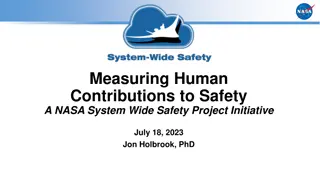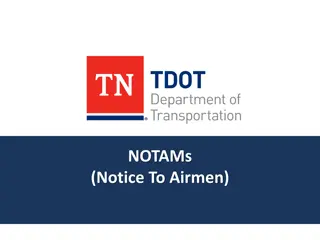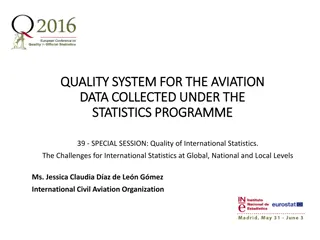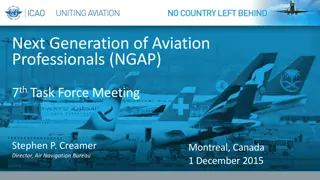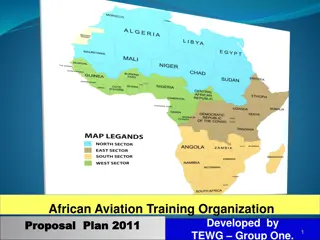The Mystery of MH 370's Disappearance - Aviation's Greatest Enigma
The vanishing of Malaysia Airlines Flight 370 in 2014 remains one of the most perplexing aviation mysteries. This article delves into known facts, radar systems, ACARS, and theories surrounding the baffling disappearance, shedding light on the complexities and uncertainties of the case.
Download Presentation

Please find below an Image/Link to download the presentation.
The content on the website is provided AS IS for your information and personal use only. It may not be sold, licensed, or shared on other websites without obtaining consent from the author. Download presentation by click this link. If you encounter any issues during the download, it is possible that the publisher has removed the file from their server.
E N D
Presentation Transcript
The Mystery of MH 370s Disappearance Ajai Banerji 2014
Introduction The disappearance of MH 370 on March 7/8 2014 may well be the greatest aviation mystery of all time. Here we compile the known facts and consider some theories as to what may have happened.
Some things we need to know Primary Radar -range is maximum 350 km. This will give only distance and heading, not altitude or other information. Secondary Radar -Similar range. It depends on the signals from the transponder fitted on most commercial aircraft. This gives the altitude, flight number, aircraft number and route data.
More things we need to know However, the secondary radar will not pick up anything if the transponder is off. The primary radar will still show the aircraft. ACARS is briefly described overleaf:
More about ACARS Aircraft Communications Addressing and Reporting System In aviation, ACARS (/ e k rz/; an acronym for Aircraft Communications Addressing and Reporting System) is a digital datalink system for transmission of short messages between aircraft and ground stations via airband radio or satellite. The protocol was designed by ARINC and deployed in 1978,[1]using the Telex format. More ACARS radio stations were added subsequently by SITA.
ACARS (continued) ACARS message types ACARS messages may be of three broad types: Air Traffic Control messages[4]are used to request or provide clearances. Aeronautical Operational Control Airline Administrative Control Control messages are used to communicate between the aircraft and its base, with messages either standardized according to ARINC Standard 633, or user-defined in accordance with ARINC Standard 618.[5]The contents of such messages can be OOOI events, flight plans, weather information, equipment health, status of connecting flights, etc. OOOI events A major function of ACARS is to automatically detect and report changes to the major flight phases (Out of the gate, Off the ground, On the ground, and Into the gate), referred to in the industry as OOOI.[6]These OOOI events are detected using input from aircraft sensors such as doors, parking brake and strut switch sensors. At the start of each flight phase, an ACARS message is transmitted to the ground describing the flight phase, the time at which it occurred, and other related information such as the amount of fuel on board or the flight origin and destination. These messages are used to track the status of aircraft and crews. Flight management system interface ACARS interfaces with flight management systems, acting as the communication system for flight plans and weather information to be sent from the ground to the FMS. This enables the airline to update the FMS while in flight, and allows the flight crew to evaluate new weather conditions or alternative flight plans. Equipment health and maintenance data ACARS is used to send information from the aircraft to ground stations about the conditions of various aircraft systems and sensors in real-time. Maintenance faults and abnormal events are also transmitted to ground stations along with detailed messages, which are used by the airline for monitoring equipment health, and to better plan repair and maintenance activities. Ping messages Automated ping messages are used to test an aircraft's connection with the communication station.[7]In the event that the aircraft ACARS unit has been silent for longer than a preset time interval, the ground station can ping the aircraft (directly or via satellite). A ping response indicates a healthy ACARS communication. Manually sent messages ACARS interfaces with interactive display units in the cockpit, which flight crews can use to send and receive technical messages and reports to or from ground stations, such as a request for weather information or clearances or the status of connecting flights. The response from the ground station is received on the aircraft via ACARS as well. Each airline customizes ACARS to this role to suit its needs. Communication details ACARS messages may be sent using a choice of communication methods, such as VHF or HF, either direct to ground or via satellite, using minimum- shift keying (MSK) modulation.[8] ACARS can send messages over VHF if a VHF ground station network exists in the current area of the aircraft. VHF communication is line-of-sight propagation and the typical range is up to 200 nautical miles at high altitudes. Where VHF is absent, an HF network or satellite communication may be used if available. Satellite coverage may be limited at high latitudes (trans-polar flights).
The flaw As of today both the transponder and ACARS can be switched off from inside the aircraft- which could happen in a hijack. Or a power failure could also affect their working, in spite of redundancy of power supplies on commercial aircraft. In such cases, the aircraft can only be tracked by primary radar if it is within range.
Further tracking by primary radar gives this path:
After this There is no tangible proof as to where the plane went. The ACARS satellite service operator then reported limited communication or handshakes after the plane went off radar. The clues were BTO and BFO.
BTO Burst Timing Offset - a measure of time taken for the signal to pass between the satellite and the aircraft. Burst Frequency Offset is basically the Doppler Effect which gives an indication of the motion (velocity and direction) of the aircraft. Complications arise with BFO since the geo- stationary satellite actually has some motion with respect to the earth
BTO and BFO (contd) Also a lot of assumptions have to be made about the plane s behaviour (was it ascending or descending, what were the initial conditions etc). Thus there is still uncertainty about the plane s crash site as the last handshakes may have occurred when fuel ran out and the power supply went off and came back. However this does match with the estimated time of fuel exhaustion.
The present search area (after detailed analysis of BTO and BFO data)
As of today After several weeks, intensive searches by underwater sensing devices have failed to find any wreckage. In fact no wreckage clearly traceable to MH 370 has been found anywhere in the world. There is now speculation that these Inmarsat communications have somehow been faked and the plane was taken somewhere else for unknown purposes.
Various theories Pilot suicide? But why fly for so many hours? Electrical fire which knocked out communications? But then how did it fly for so many hours? Hijacking-not so easy now. What was the motive? (release of prisoners?) Nothing has been publicized. Or kidnapping or theft of cargo? No clear proof.
Hijacking? If hijacked, why was it flown to a remote place where there was nowhere to land?
Preventive measures There should be no way for the crew to shut off transponders or other means of communications in flight. The need for shutdown may arise on rare occasions such as electrical breakdowns. Nowadays continuous satellite tracking of all data is technically and economically feasible.
Prevention (continued) In that case the need to find the black boxes is reduced as the data will be available immediately. The limitations of data storage (especially for the cockpit voice recorder) will not apply. Pilot s unions may protest against this (especially cockpit voice recordings for long durations). This will remain foolproof only if it cannot be switched off in flight.
Prevention (continued) There have been some recent instances of crashes being deliberately caused by pilots including (Silk Air 1997, Egyptair 1999) which resulted in heavy casualties. So closer monitoring of mental health of cockpit crew may be needed.
Conclusion As of today the location of the aircraft remains a mystery. Even if the wreckage is found the sequence of events may not be clear. The cockpit voice recorder will only show the last 30 minutes which may not be helpful. The only clear thing we know is that there was some deliberate interference by unknown persons.
References Many articles in the mass media. Basic information can be found in articles in Wikipedia. More detailed studies in the blog www.jeffwise.net







